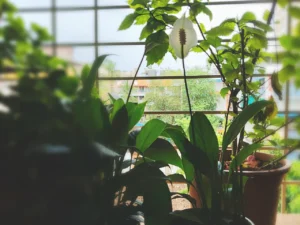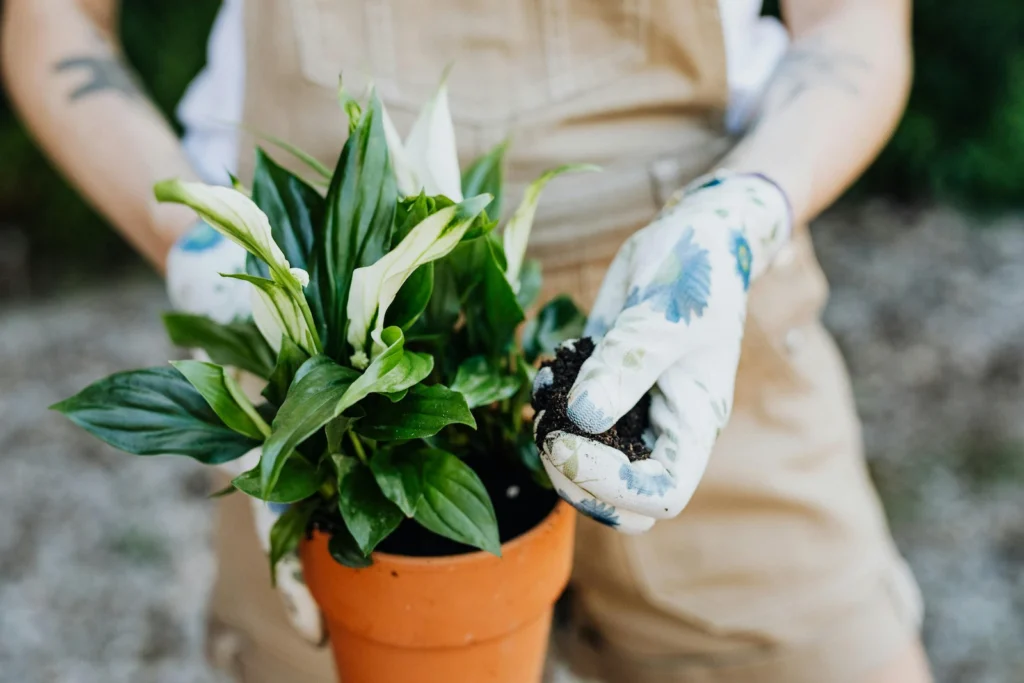
If you have been growing plants at your home then one thing that will always make you happy is the day when you see the bud growing in your plants. You know it’s going to bloom into a flower soon. It is the equivalent feeling of your kids growing up, finishing their college and becoming a full grown adult to explore the world. For plant parents, peace lily flowers can bring the same joy. However there are some aspects of flowering in a peace lily that needs to be kept in mind. Let’s have a look at some of those.
Peace Lily Flowers
Peace lilies(Spathiphyllum) are houseplants that many people opt to buy these days. These plants are known for their beautiful, white, snake-hood like flowers and lush, dark green leaves. But there’s a twist. The peace lily produces distinctive white flowers, called spathes, which are actually modified leaves and not the actual flower. The true flowers are tiny and clustered on the spadix, a spike in the center of the spathe.


Flowering cycle in days
Flower Initiation: The initiation of new flowers can take around 20 to 30 days, depending on the plant’s environment and care. Once initiated, the flower buds take about 30 to 45 days to develop and mature. The peace lily can remain in full bloom for about 30 to 40 days, during which time the spathe (the white, hood-like structure) is fully unfurled and the spadix (the central column) is visible. After the peak bloom, the flowers will start to fade. This stage can last about 10 to 20 days. The spathe may turn green or brown and begin to wilt, signaling the end of the flowering cycle.
How to Make Peace Lily Flower?
Unless this question is about Origami where you want to ‘make peace lily flowers’, you can help peace lily plants to sprout flowers. There are some simple things that you can do –
Balanced Fertilizer
Use a balanced, water-soluble fertilizer (20-20-20) diluted to half strength once every 6-8 weeks during the growing season (spring and summer). It is okay to under-fertilize than to over-fertilize the soil to avoid root burn.
Sunlight & Intensity
This plant thrives well in bright, indirect light. Place your plant near a window where it can receive filtered sunlight.
Pro tip: Direct sunlight can scorch the leaves. A north or east-facing window is often ideal. Basically ample sunlight, but not more to burn the living hell out of it.
Watering needs
Keep the soil moist but not waterlogged. Water the plant when the top inch of soil feels dry. Dip your finger and check for moisture level.
Pro-tip: Avoid Overwatering. Ensure good drainage so that excess water flows out of the pot – this helps prevent root rot.
Atmosphere
Peace lily loves high humidity. Misting the leaves regularly helps maintain humidity, especially in winters where the air is dry. Some people prefer creating a humidity tray filled with pebbles and water. When water evaporates in the tray, it increases the humidity around the plant. If you can afford, use a humidifier if you are growing the plant in a room which is quite dry.
Other important factors to consider
– Maintain the temperature around the plant between 65-80°F (18-27°C). No one likes sudden change in the temperature, so do your plants.
– If you have outgrown your shoe size, get a new pair of shoes that accommodate your feet. If the plant has outgrown the pot size, repot so that roots grow freely.
– Keep the leaves clean. Clean leaves help with more surface area available for photosynthesis and transpiration.
Pro Tip:
- Avoid repotting and fertilization during dormancy period (especially in winters), they will flower up when the spring season comes up again.
- Maintain consistent watering schedules, temperature and humidity level. Let the plant focus on flowering while you take care of its other core requirements.
Peace Lily Flowering Season
The flowering season for peace lilies (Spathiphyllum) in various regions, including India, the USA, Australia, and European countries, generally aligns with the warmer months of spring and summer. However, the specific timing can vary slightly depending on the local climate in a region. In India, peace lilies typically bloom from March to June months in a year, coinciding with the warmer, more humid months before the monsoon season. Fortunately, the tropical and subtropical climate in most parts of India supports year-round growth, but flowering is most prolific during the warmer seasons.
In the United States, peace lilies commonly bloom from late March to September. Given the diverse climates across the country, indoor growing conditions may vary. Southern states might see extended flowering periods compared to northern states.
In Australia, peace lilies generally flower from September to February, aligning with the Southern Hemisphere’s spring and summer. In regions with mild winters, such as coastal areas, peace lilies can sometimes bloom sporadically year-round. In most European countries, peace lilies bloom from April to August. Due to the cooler climate in many parts of Europe, maintaining proper indoor conditions is crucial for flowering. Ensuring adequate light and warmth can extend the blooming period.
Peace Lily Flowers Turning Green
Peace lily flowers turning green is a common phenomenon and typically occurs due to natural aging or some environmental factors. Here’s a detailed explanation:
Causes of Green Flowers
Natural aging, flower maturation, bloom cycle, varied light conditions, over-fertilization, fluctuations in temperature and humidity
Peace lily flowers start white and gradually turn green as they age. This is a normal part of the flower’s life cycle. After the initial bloom period, the spathe (the white part of the flower) will often turn green before eventually wilting and dying.
If a peace lily is exposed to too much light, the flowers can turn green faster. Peace lilies prefer bright, indirect light. While peace lilies can tolerate low light, insufficient light can also cause flowers to turn green or prevent them from turning white. Over-fertilizing can lead to greener flowers. Peace lilies need a balanced, water-soluble fertilizer, but too much nitrogen can affect flower color. Extreme temperature changes or drafts can stress the plant and cause the flowers to turn green whereas inadequate humidity can affect the overall health of the plant, including the flower color.
Science behind peace lily flowers turning green
The peace lily flower consists of a spathe, which is the large, white, leaf-like bract, and the spadix, which is the central spike covered in tiny flowers. When the peace lily flower first blooms, the spathe is white. This white color serves to attract pollinators, providing a contrast to the green coloured leaves as background. As the flower ages, chlorophyll (the green pigment responsible for photosynthesis) begins to develop in the spathe. This process is similar to what happens in the leaves of the plant. Now, the increased chlorophyll allows the aging spathe to contribute to photosynthesis, helping the plant generate energy and nutrients.
The transition from white to green often indicates that the flower is past its prime reproductive stage. The white color attracts pollinators when the flower is ready for pollination. After this period, the plant shifts its focus back to vegetative growth.By turning green, the spathe becomes photosynthetically active, aiding in the overall energy production for the plant, which is crucial after the reproductive phase. As flowers age, they produce more ethylene, a plant hormone that promotes senescence (aging). This increase in ethylene can trigger the development of chlorophyll in the spathe. Ethylene is the same gas that helps ripen the fruits like bananas, apples, papayas, oranges, etc.
The balance of other hormones like cytokinins and auxins also changes as the flower ages, contributing to the color transition and eventual wilting of the spathe.
Adequate light is necessary for chlorophyll production. Flowers exposed to sufficient light will develop chlorophyll more readily, turning green faster. Temperature can affect the rate of aging and chlorophyll production. Moderate temperatures promote gradual aging, while extreme temperatures can accelerate the process.
Peace Lily Brown Flowers
Naturally, all flowers will wilt away once they have bloomed.
Some of the common reasons why your peace lily plant has brown flowers are – natural aging, overwatering or underwatering, direct sunlight on flowers, exposure to cold drafts or high temperatures, insufficient humidity, lack of nutrients or over-fertilization, and insects & fungal infections.
Simple prevention tips for browning of flowers
Water when the top inch of soil is dry and ensure good drainage. Provide bright, indirect light and avoid direct sunlight. Keep the surrounding temperatures around the plant between 65-80°F (18-27°C) and avoid drafts (windy areas). Increase the humidity by misting the leaves where you can use a humidity tray, or a humidifier. Use balanced fertilizer every 6-8 weeks during the growing season and avoid over-fertilizing. Regularly inspect the plant and treat for pests or diseases as needed.
Pro-Tip: Prune (Remove) brown or dead flowers to encourage new growth and maintain appearance. Removing a bloomed flower helps plants to focus nutrition on the new buds and other parts of the plants rather than catering nutritions to the already dying flowers when it has surpassed the blooming stage.
FAQs
1. Why are my peace lily flowers green?
Peace lily flowers turn green as they age and develop chlorophyll for photosynthesis. The white spathe is actually a modified version of leaf.
2. When does a peace lily flower?
Peace lilies typically flower in spring and summer.
3. Can you repot peace lily while flowering?
Yes, you can repot a peace lily while it’s flowering, but it’s best to wait if possible to avoid stressing the plant.
4. Do peace lily flowers have seeds?
Yes, peace lily flowers can produce seeds, but it’s uncommon and they are usually propagated by division.
5. What is a peace lily with red flowers?
A peace lily with a red flower is likely a different plant, possibly an Anthurium, which is often mistaken for a peace lily.
6. Do peace lily flowers die?
Yes, peace lily flowers die as part of their natural lifecycle.
7. Why is my peace lily not flowering?
Your peace lily may not be flowering due to insufficient light, improper watering, low humidity, nutrient deficiencies, or temperature extremes.


